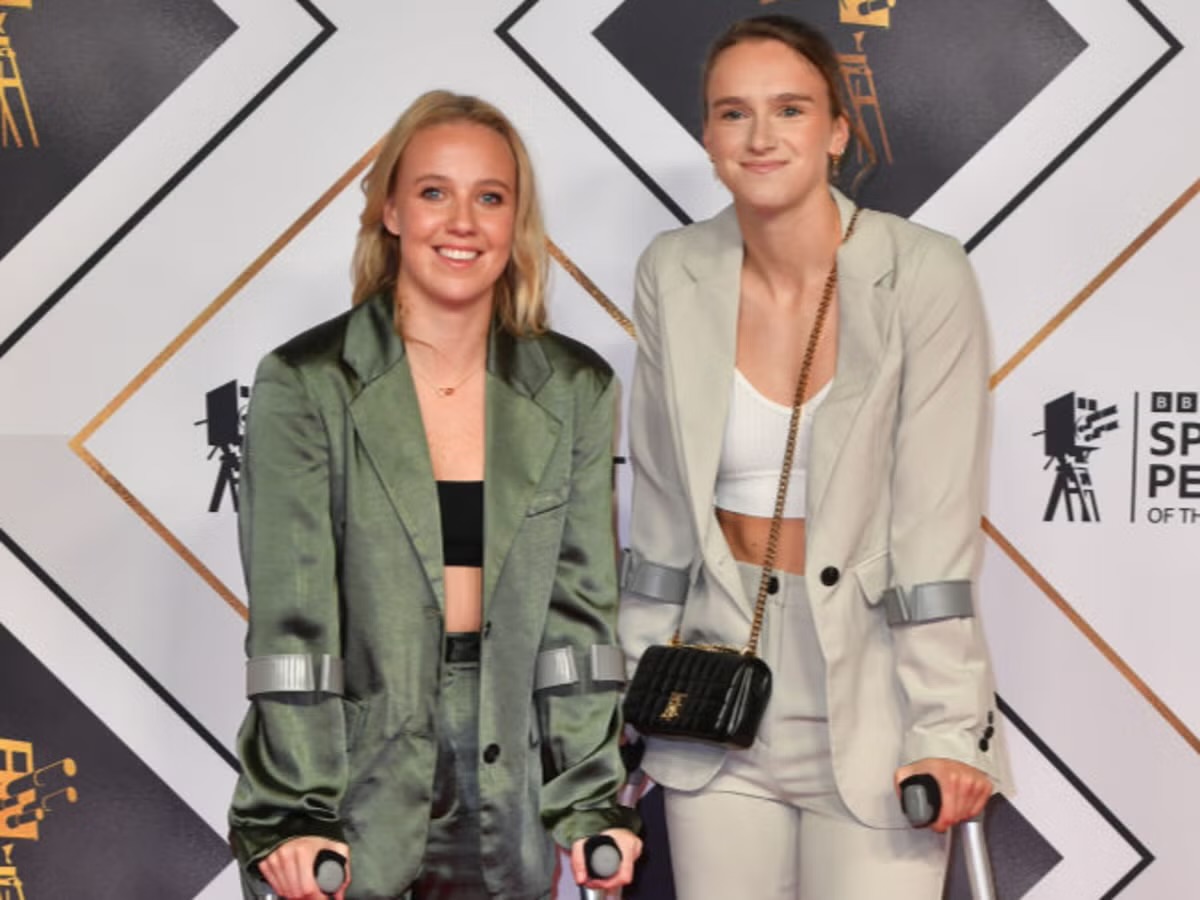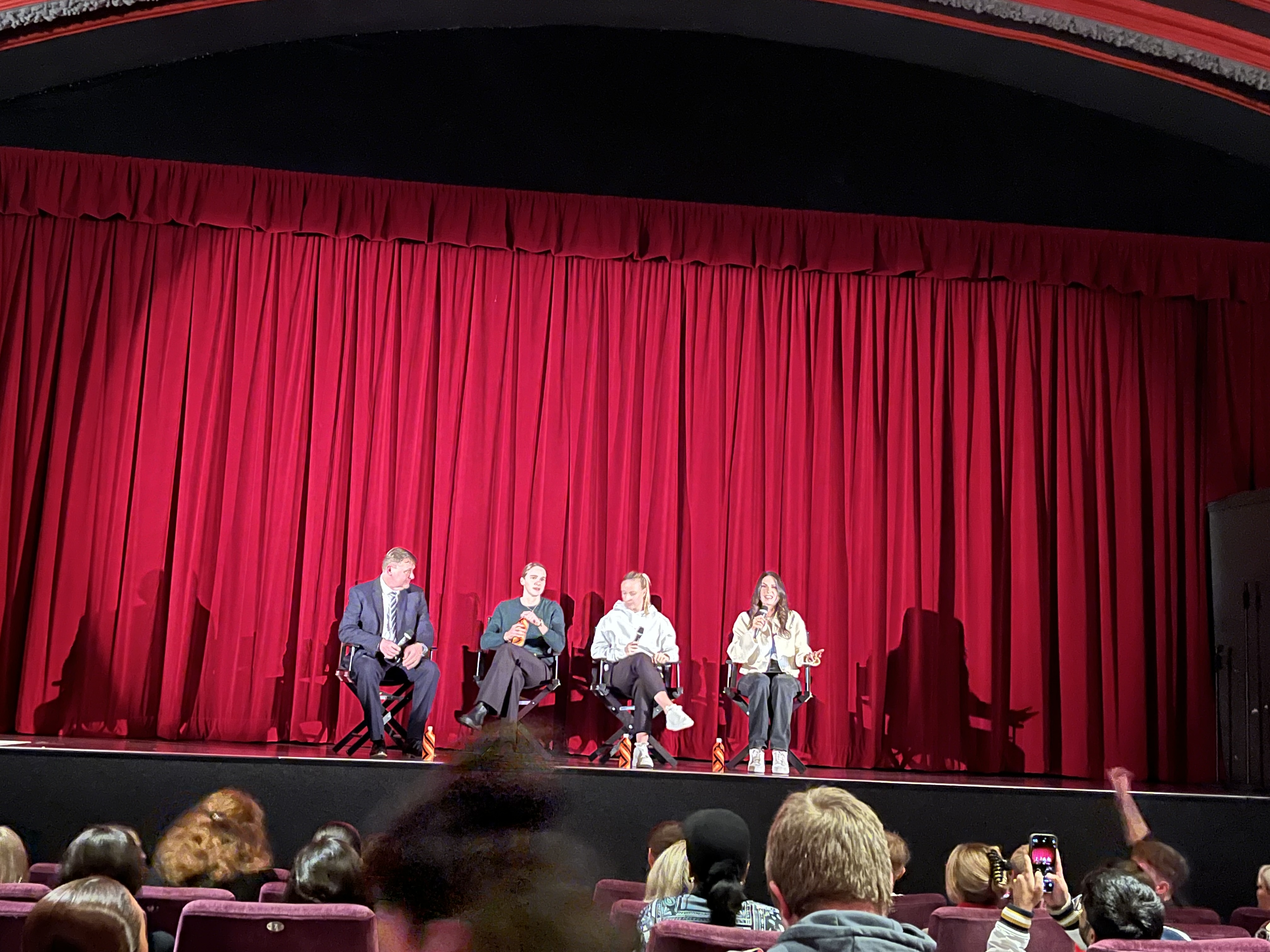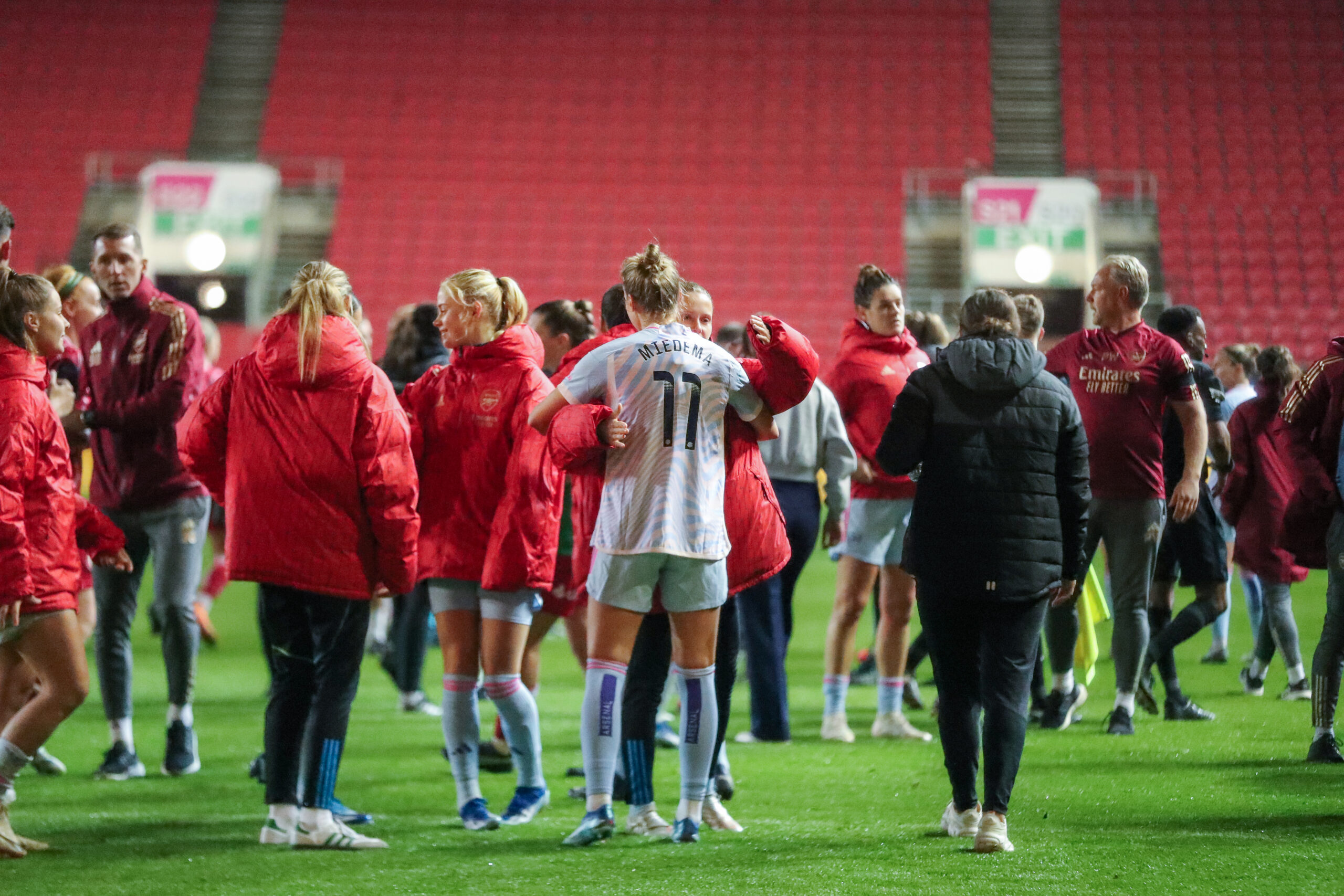On Monday evening, Arsenal premiered ‘Step by Step- Viv and Beth’s ACL Journey’ at the Screen on the Green on Upper Street. It’s a five-part documentary detailing the ACL recoveries of Arsenal forwards Beth Mead and Vivianne Miedema and delves into some of the key causes that mean female footballers are somewhere between 6-8 times more likely to rupture their ACL than their male counterparts.
Mead and Miedema ruptured their ACLs within three and a half weeks of one another last autumn. It was terrible luck for Arsenal and pretty much cost them their anticipated title tilt, ill fortune that was compounded by the fact that defenders Leah Williamson and Laura Wienroither endured the same injury in the spring. Fellow defender Teyah Goldie ruptured hers- her second ACL injury- in June.
Of course, what makes Mead and Miedema’s situation unique is that they are a couple. Same sex relationships are very commonplace in women’s football and what is striking, on reflection, is that it is not striking at all that a gay couple feel comfortable to be this open in a deeply personal documentary.
Women’s football is not quite a utopia when it comes to inclusion, as we detailed in our piece last month on the lack of ethnic diversity in both the Arsenal squad and more widely across women’s football. However, there is a lot to be said for a gay female couple to be intimate with a wide audience about their relationship in this way and for it to look and feel so unremarkable within the context of the women’s game.
The other aspect of the documentary that is striking is that the players themselves were the protagonists for it. There are lots of intimate shots that were filmed by Beth and Viv on their phones as they sought to diarise their almost simultaneous recoveries. The ‘almost simultaneous’ part clearly represents a challenge for Miedema, who ruptured her ACL after Beth and therefore slightly lagged her recovery timeline.
At the screening there was a subsequent Q&A with Viv, Beth and Head of Medicine and Sports Science at Arsenal Women Gary Lewin. In that Q&A Viv said, ‘we wanted to get our story out there’ and a sidebar to this is the emerging sense of comfort top female players are beginning to feel as public figures.

But within the documentary, there are discussions with a series of specialists in fields like female biomechanics, menstruation and sports psychology as the players sought to come to grips with the factors behind the female ACL epidemic. Viv and Beth said they wanted to shoot a documentary to get some answers for the next generation of female athletes.
A sense of ‘throwing the ladder down’ has always permeated with women footballers. There are so many barriers erected for girls to play football that most of those who make it professionally have to fight so hard to surmount them and that usually comes with a feeling of responsibility for the next generation. One of the factors behind the ACL epidemic, discussed at length in the documentary, is the lack of strength and conditioning afforded to girls in academies.
‘When we get boys in the academy,’ says Gary Lewin, ‘We get them at 9 years old and they start S&C then. With girls, we get them at 18 and that’s when they start S&C.’ While the frequency of ACL injuries in female athletes is multi factored (and therefore does not contain singular answers) this is seen as a key driver. ‘If we’re up here again in ten years having this conversation, we have failed,’ concludes Lewin.
I have covered women’s football for some years and the ACL epidemic is nothing new and while I have heard a lot of the factors discussed and weighed up, there are still nuggets of information in Step By Step that are new and interesting. For instance, understanding the menstrual cycle and its impact on the biomechanics of female athletes is posited as a factor in the prevalence of this injury. This has been discussed at length in various circles.
There is an interview with an expert in female menstruation who is clearly irritated by how this discussion has been framed, suggesting that the menstrual cycle is, in and of itself, not a cause- because these injuries happen at all stages of the cycle. Rather, it has been a failure to understand the menstrual cycle that has proved to be an issue.
Arsenal have experimented with injury recovery documentaries before, they produced a short one on Jordan Nobbs’ ACL recovery back in 2019 and, on the men’s side, they charted Gabriel Jesus’ rehab from a knee injury last year. This documentary is more layered, though. There is great texture to this story with the wider conversations around ACL injuries in female athletes.
There is also a great level of intimacy underpinning a lot of the scenes. For instance, there is a really touching and amusing moment where Beth has to wash Viv’s feet in a tub of warm water. Miedema is immediately post-surgery and unable to wash her own feet. In the subsequent Q&A, Lewin talked about how female athletes often have to face up to recovery alone, which is damaging psychologically.
Elite male athletes, he argues, often have their families around them, their agents, their handlers, cooks, cleaners etc. Female footballers often live on their own. Beth and Viv talk a lot about how facing recovery together, on a similar timeline, was very helpful for them. When Laura Wienroither ruptures her ACL in May, Beth and Viv take her into their home.
The immediate stages of recovery are often very taxing because post surgery, it is difficult to walk and to shower. To face that alone is a logistical challenge as well as a psychological one. The scenes with the couple taking Wienroither in are moving and speak to a solidarity between female athletes. Miedema, Mead and Lewin all talk about how the ACL injuries brought the squad closer together in a way that, at the risk of generalising, I am not sure you see in a men’s squad in quite the same way.
That said, Lewin told us that Miedema is in regular contact with her compatriot Jurrien Timber, who is recovering from an ACL injury and said that Rob Holding regularly touched base with the four Arsenal players in recovery prior to his move to Crystal Palace this summer. Holding ruptured his ACL at a similar time to Jordan Nobbs in the winter of 2018 and the two built a close bond during their respective rehabs.
The challenges of recovery are charted in an intimate way too. There is an underscore of grief and loss as Beth’s mum June entered the terminal stages of cancer in the immediate aftermath of Mead’s injury. In fact, the players discuss potential psychological factors behind their respective injuries. Both of them ruptured their ACLs in the days following bad prognoses for June and wonder aloud whether their psychological state contributed to their injuries.
Viv speaks of having a migraine in the build-up to the Lyon match where she suffers her injury and how she considered her participation in the match. She also says, touchingly, that her first thought when she injured her knee was that she would no longer be able to drive Beth home for Christmas- a Christmas they both knew would very likely be June’s last.

Clearly, there is an additional challenge for Miedema in her recovery. Having ruptured her ACL nearly a month after Mead, she has to deal with that timeline lag and watch Mead hit some key milestones- running in the anti-gravity machine, running outdoors, working with the ball- before her, which has to present challenges.
What comes across is the difference in the two characters as well and how they used those differences to aid the rehab process, as well as in their relationship. Beth described herself as ‘like a kid at Christmas’ the first day that she could run outdoors, while Viv talks about a feeling of anxiety and reluctance every time she hits a key milestone.
The pair had very different experiences at the moment they incurred their injuries. Because the initial pain and shock disappears quite quickly for some people that suffer an ACL rupture, Beth described feeling reasonably positive that her scan would reveal something more minor. Whereas Viv says she knew straight away what she had done and immediately processed the fact that she was going to miss the World Cup into the bargain.
The documentary paints a picture of a rehab process that is gruelling and difficult with the pain of watching your teammates go outside to train while you undergo repetitive and quite dull strengthening drills. The medical staff have to effectively teach the players to walk and run again so that they don’t overcompensate or limp and so they can try to mitigate against future damage. The players are at London Colney stepping up their recovery when the World Cup starts.
Overall, the mental challenge of recovery looks as difficult as the physical challenge. Step by Step illustrates a confidence and increasing media literacy of elite female footballers. Women’s football fans are, more than men’s football fans, invested in player characters and personalities generally speaking. Many of them arrive at the teams they support through an admiration of individual players.
There are plenty of Arsenal Women fans who will tell you they support Arsenal because of one or both of Viv and Beth. Their willingness to be intimate about their own lives, their own recoveries and their relationship is genuinely touching and some of the best scenes are relatively ‘normal’ domestic scenes (the shots where Beth FaceTimes Viv pre surgery, for example. Or when Viv cautions Beth to be careful ahead of her first outdoor run).
Gary Lewin’s prominence, as well as the experts he enlists in a number of fields related to female ACL injuries, gives the documentary another interesting angle- even as someone who, frankly, feels saturated by the subject matter over the years. I perhaps would have liked a little more detail on what each stage of recovery actually looks like- maybe that occurs in parts 4 and 5 and, in any case, I imagine it is probably a challenge to present material like that in a way that isn’t overly dry.
 Leah Williamson, who also ruptured her ACL in April, barely features in the documentary. However, the situation is different for her. Wienroither is further from her home and her family in Austria, whereas Leah will have support networks closer by. Beth and Viv’s ‘adoption’ of Laura is genuinely touching. Jonas Eidevall is not a talking head in the first three parts of the documentary either. Again, maybe we hear more from him in parts 4 and 5 but I would have liked to see him a little more, as well as other members of the medical staff (again, maybe that awaits in parts 4 and 5).
Leah Williamson, who also ruptured her ACL in April, barely features in the documentary. However, the situation is different for her. Wienroither is further from her home and her family in Austria, whereas Leah will have support networks closer by. Beth and Viv’s ‘adoption’ of Laura is genuinely touching. Jonas Eidevall is not a talking head in the first three parts of the documentary either. Again, maybe we hear more from him in parts 4 and 5 but I would have liked to see him a little more, as well as other members of the medical staff (again, maybe that awaits in parts 4 and 5).
If you are a fan of the players, the intimacy and frankness of the couple as they chart their various challenges is firmly in ‘will occasionally make you laugh and often make you cry’ territory. Lewin’s prominence as the ‘supporting cast’, if you will, adds a layer of medical intrigue and expertise which I think will really appeal to an audience that is tangentially aware of the female ACL epidemic and curious about the causes.
The documentary illustrates how women’s football is able to provide a very personal, authentic level of content. It is not often that two Ballon D’Or nominees will expose their lives to this extent. Step By Step is an intimate story of loss, grief and recovery.
Step by Step is a five part documentary that will air on Arsenal.com very soon.





Excellent write up Tim, really looking forward to watching it.
Excellent review Tim, than you. We are talking, arguably, about two of the best players of their game in the world added to which they are both infinitely likable, lovable maybe, not controversial at all but they do it all with one thing in mind: to play the game they love and that we love to see them play.
A cheeky nickname of Meadema could me Mead.
I always try hard to squeeze out a pun. Please be grateful.
Looking forward to this one.
Oh really glad you reviewed this Tim, thank you. I would have missed it but sounds like a must watch.
A frank and sensitive review Tim. This has definitely piqued my interest and I’ll be watching out for the documentary on The Arsenal website. Its great that our football team wants to share so much about what goes on in the background and off the pitch.